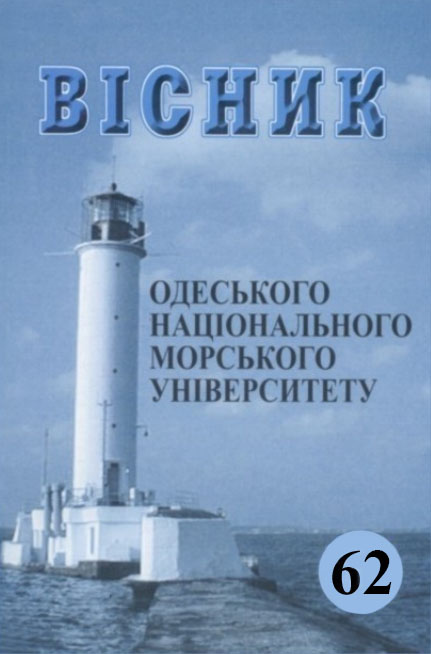Комплексное управление выпускными газами судовых дизелей как способ обеспечения их экологических показателей работы
##plugins.themes.bootstrap3.article.main##
Аннотация
Приведены результаты исследований по влиянию систем рециркуляции и перепуска выпускных газов на экологические и экономические показатели работы судового дизеля 16V32 фирмы Wartsila-Sulzer. Предложено использование комплексной системы управления выпускными газами, сочетающей в себе названные системы. Экспериментально подтверждено, что комплексное управление выпускными газами дизеля 16V32 обеспечивает снижение эмиссии оксидов азота на 31,27-38,23 % при увеличении удельного эффективного расхода топлива
на 2,68-1,11 %.
##plugins.themes.bootstrap3.article.details##
Как цитировать
Куропятник, А. (2020). Комплексное управление выпускными газами судовых дизелей как способ обеспечения их экологических показателей работы. Весник Одеского национального морского университета, (62), 142-159. https://doi.org/10.47049/2226-1893-2020-2-142-159
Раздел
Технические проблемы эксплуатации судового энергетического оборудования
Литература
1. Sagin, S.V., Solodovnikov, V.G. (2015). Cavitation Treatment of High-Viscosity Marine Fuels for Medium-Speed Diesel Engines. Modern Applied Science, vol. 9, no. 5, pp. 269-278. DOI:10.5539/ mas. v9n5p269.
2. Sagin, S.V., Semenov, O.V. (2016). Marine Slow-Speed Diesel En-gine Diagnosis with View to Cylinder Oil Specification. American Journal of Applied Sciences, vol. 13, no. 5, pp. 618-627. DOI: 10.3844/ajassp.2016.618.627.
3. Kuropyatnyk, O.А. (2018). Znyzhennya emisiyi oksydiv azotu sud-novyx dyzeliv metodom perepusku vypusknyx gaziv [Reduction of nitrogen oxides of marine diesel by exhaust gas bypass]. Visnyk Odeskogo nacionalnogo morskogo unyversytetu, no. 4(57), pp. 98-108.
4. Sagin, S.V., Kuropyatnyk, О.А. (2018). The Use of Exhaust Gas Recirculation for Ensuring the Environmental Performance of Marine Diesel Engines. OUR SEA: International Journal of Mari-time Science & Technology, vol. 65, no 2, pp. 78-86. doi.org/ 10.17818/NM/ 2018/2.3.
5. Zablotsky, Yu.V., Sagin, S.V. (2016). Enhancing Fuel Efficiency and Environmental Specifications of a Marine Diesel When using Fuel Additives. Indian Journal of Science and Technology, vol. 9, no. 46, pp. 353-362. DOI: 10.17485/ijst/2016/v9i46/107516.
6. Kuropyatnyk, O.A., Sagin, S.V. (2019). Exhaust Gas Recirculation as a Major Technique Designed to Reduce NOх Emissions from Marine Diesel Engines. OUR SEA: International Journal of Mari-time Science & Technology, vol. 66, no. 1, pp. 1-9. doi.org/ 10.17818/ NM/2019/1.1.
7. Yeryganov, O., Varbanets, R. (2018). Features of the fastest pres-sure growth point during compression stroke. Diagnostyka, vol. 19, no. 2, pp. 71-76. http://dx.doi.org/ 10.29354/diag/89729.
8. Sagin, S.V., Solodovnikov, V.G. (2017). Estimation of Operational Properties of Lubricant Coolant Liquids by Optical Methods. International Journal of Applied Engineering Research, vol. 12, no. 19, pp. 8380-8391.
9. Kuropyatnyk, O.A. (2020). Reducing the emission of nitrogen oxides from marine diesel engines. Materials of the International Conference «Scientific research of the SCO countries: synergy and integration», Beijing, PRC, January 25, 2020, vol. 2, pp. 154-160. DOI. 10.34660/INF. 2020.24.53689.
10. Sagin, S.V., Kuropyatnyk, О.А. (2017) Application of the system of recirculation of exhaust gases for the reduction of the concentra-tion of nitric oxides in the exhaust gases of the ship diesels. Ameri-can Scientific Journal, no. 15, iss. 2, pp. 67-71.
2. Sagin, S.V., Semenov, O.V. (2016). Marine Slow-Speed Diesel En-gine Diagnosis with View to Cylinder Oil Specification. American Journal of Applied Sciences, vol. 13, no. 5, pp. 618-627. DOI: 10.3844/ajassp.2016.618.627.
3. Kuropyatnyk, O.А. (2018). Znyzhennya emisiyi oksydiv azotu sud-novyx dyzeliv metodom perepusku vypusknyx gaziv [Reduction of nitrogen oxides of marine diesel by exhaust gas bypass]. Visnyk Odeskogo nacionalnogo morskogo unyversytetu, no. 4(57), pp. 98-108.
4. Sagin, S.V., Kuropyatnyk, О.А. (2018). The Use of Exhaust Gas Recirculation for Ensuring the Environmental Performance of Marine Diesel Engines. OUR SEA: International Journal of Mari-time Science & Technology, vol. 65, no 2, pp. 78-86. doi.org/ 10.17818/NM/ 2018/2.3.
5. Zablotsky, Yu.V., Sagin, S.V. (2016). Enhancing Fuel Efficiency and Environmental Specifications of a Marine Diesel When using Fuel Additives. Indian Journal of Science and Technology, vol. 9, no. 46, pp. 353-362. DOI: 10.17485/ijst/2016/v9i46/107516.
6. Kuropyatnyk, O.A., Sagin, S.V. (2019). Exhaust Gas Recirculation as a Major Technique Designed to Reduce NOх Emissions from Marine Diesel Engines. OUR SEA: International Journal of Mari-time Science & Technology, vol. 66, no. 1, pp. 1-9. doi.org/ 10.17818/ NM/2019/1.1.
7. Yeryganov, O., Varbanets, R. (2018). Features of the fastest pres-sure growth point during compression stroke. Diagnostyka, vol. 19, no. 2, pp. 71-76. http://dx.doi.org/ 10.29354/diag/89729.
8. Sagin, S.V., Solodovnikov, V.G. (2017). Estimation of Operational Properties of Lubricant Coolant Liquids by Optical Methods. International Journal of Applied Engineering Research, vol. 12, no. 19, pp. 8380-8391.
9. Kuropyatnyk, O.A. (2020). Reducing the emission of nitrogen oxides from marine diesel engines. Materials of the International Conference «Scientific research of the SCO countries: synergy and integration», Beijing, PRC, January 25, 2020, vol. 2, pp. 154-160. DOI. 10.34660/INF. 2020.24.53689.
10. Sagin, S.V., Kuropyatnyk, О.А. (2017) Application of the system of recirculation of exhaust gases for the reduction of the concentra-tion of nitric oxides in the exhaust gases of the ship diesels. Ameri-can Scientific Journal, no. 15, iss. 2, pp. 67-71.
